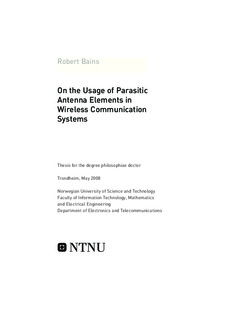| dc.contributor.author | Bains, Robert | nb_NO |
| dc.date.accessioned | 2014-12-19T13:42:37Z | |
| dc.date.accessioned | 2015-12-22T11:39:49Z | |
| dc.date.available | 2014-12-19T13:42:37Z | |
| dc.date.available | 2015-12-22T11:39:49Z | |
| dc.date.created | 2008-06-10 | nb_NO |
| dc.date.issued | 2008 | nb_NO |
| dc.identifier | 124527 | nb_NO |
| dc.identifier.isbn | 978-82-471-9211-5 | nb_NO |
| dc.identifier.uri | http://hdl.handle.net/11250/2368821 | |
| dc.description.abstract | Multiple-Input-Multiple-Output (MIMO) is a technology that uses multiple antennas at both the transmitter and the receiver to be able to enhance the spectral efficiency. This technology gained a high popularity among researchers, which shows off in the high number of publications on the area. There are however some drawbacks when it comes to how many antennas may be put inside a small volume, when it is required that each additional antenna should give a substantial increase in the obtained spectral efficiency. This dissertation considers an alternative approach for achieving higher capacities.
Part I of the thesis explores the concept of a virtually fast rotating directional receive antenna, which rotates once or several times during a symbol interval. The antenna rotation is obtained by using a single active antenna element and multiple parasitic elements. This concept has some similarities with MIMO technology, but also many differences. The rotating antenna consists of multiple antennas which also MIMO receivers do. In addition, the antenna rotation results in spatial multiplexing, which is also obtained by MIMO receivers. It is shown in the thesis that the rotating receiver antenna provides a much higher capacity than a single receiver antenna. But at the same time, it looses in terms of capacity performance when comparing with multiple antennas that occupy the same volume as the rotating antenna.
Part II of the thesis considers a novel compact transmitter that consists of a single active antenna element and multiple parasitic elements. The parasitic elements are used for creating directive antenna patterns. The directive antenna patterns are not used for achieving high signal-to-noise ratio (SNR) at the receiver as in beamforming, but rather the choice of antenna pattern itself represents information. The transmitter encodes information both by the choice of antenna pattern (chooses possibly a different antenna pattern on each symbol interval) and the choice of symbol to be transmitted with the antenna pattern. The spectral efficiency obtained by this scheme is demonstrated to be comparable to the performance of widely spaced antennas.
The similarity between Part I and I I of the thesis is that in both cases a single active antenna element and multiple parasitic elements are considered. In addition, the parasitic elements are used for creating antenna patterns, which means that the mutual coupling between the antenna elements is taken advantage of. | nb_NO |
| dc.language | eng | nb_NO |
| dc.publisher | Fakultet for informasjonsteknologi, matematikk og elektroteknikk | nb_NO |
| dc.relation.ispartofseries | Doktoravhandlinger ved NTNU, 1503-8181; 2008:156 | nb_NO |
| dc.title | On the Usage of Parasitic Antenna Elements in Wireless Communication Systems | nb_NO |
| dc.type | Doctoral thesis | nb_NO |
| dc.contributor.department | Norges teknisk-naturvitenskapelige universitet, Fakultet for informasjonsteknologi, matematikk og elektroteknikk, Institutt for elektronikk og telekommunikasjon | nb_NO |
| dc.description.degree | PhD i elektronteknikk | nb_NO |
| dc.description.degree | PhD in Electrical Engineering | |
